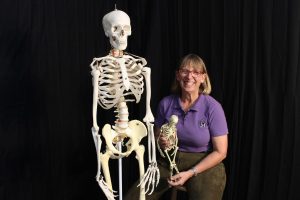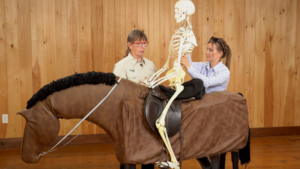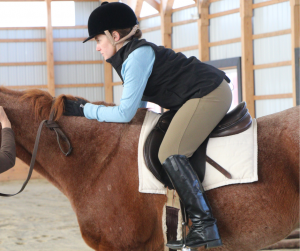In many classical riding schools, riders were taught jumping before dressage.
By learning to jump, these riders learned how to go with their horse, follow their movement, go forward, and not micro-manage every stride.
The horses also learned confidence, coordination, and developed power in their movement.
For the rider, jumping position, done correctly, teaches the most fundamental movement of good riding – fluid movement in the hip joints.
However, many of the riders I know that start riding and jumping, especially as an adult, are not taught how to feel this movement in their hips for jumping – or for riding on the flat.
As a result, jumping can feel pretty scary, with riders feeling like all they really know to do is “hang on”!
There is also a misconception that to jump, the rider needs to “get into jumping position”.
In reality, the horse’s motion over the jump folds the rider into the jumping position – as long as the rider is not tense and bracing, and understands how to remain fluid through their hip joints.
This is why the classical riding schools taught jumping first – learning to follow the horse with fluid hips is every bit as important when riding on the flat as it is over jumps.
In today’s video, I am here with Wendy Murdoch, anatomy and movement expert and instructor of our Effortless Rider Jumping Course, to share one exercise you can do while watching the video to feel this fluid movement and understand jumping position – and get the benefits even if you don’t jump!














23 Responses
I do not ride jumpers, or english, although I love to watch, I show reiners and ranch horse. But I have to say that your information is very good, great visuals, and I have incorporated some into my rides. Also, I do jump my one western gelding, as he likes it and I think it breaks up the monotony, though in my western saddle.. LOL
Thank you April! Good, foundational riding is the same regardless of the tack!
Hi Callie and Wendy, thanks for the video. I will definitely try it at home and the next time I get on a horse (it’s been a while). One problem I had in jumping was to start off in the jumping position way before the actual jump. When I would be in the sitting canter and try to jump, I found that because I was not relaxed, I would not follow the horse’s movement and automatically come to the jumping position. This is a problem I have ti try and solve myself.
This is a common problem, jumping in grids with your eyes closed is an excellent exercise for learning to follow the horses movement and not anticipate!
Even after nearly 45 years of riding (and I’m much older than that!), I still catch myself folding at the waist rather than hips over jumps. This exercise will really help me get a better sense of how it should feel when I bend correctly – thank you! My other challenge is that, no matter how I bend, my knees tend to want to move apart a bit, so any suggestions on that would be great also! (I’m slim and very long-legged at 5’10).
Hi Lisa, I would recommend exploring what your range of motion is before you notice your knees moving apart. Try folding forward just a few inches, and notice when you start to become more tight. Return to upright. The tension is likely what is pulling your knees apart, an overcompensating and using more effort than is necessary. Work on just those little movements that you can do smoothly and then expand on those.
Wendy and Callie, Your anatomical illustrations and explanations are fantastic. They are clear and concise. Thanks for clarifying the meaning of opening and closing the hip angle.
Glad this was helpful Judy!
Callie & Wendy, this was a great explanation of how to move your hips. With both hips replaced, I have a hard time getting them to move correctly so this will be a good exercise for mw to do on the ground and on my horse. Thank you!
These visuals are so beneficial!
Callie and Wendy
Thank you so much for that demonstration. I am coming back into riding with a Spinal Cord Injury and a Cage replacing my burst L3. This demonstration assists me to visualize what’s meant to be happening inside my body as I have no sensation and will be most helpful in my journey to ride again.
Thank you.
It is so helpful to be able to visualize what is actually happening with our body!
I find the work you do with Wendy so valuable. All your lessons are helpful. Thank you. I will be paying attention to my hips and how they move on the horse. Thank you.
So glad you enjoy these videos with Wendy Marjorie!
This exercise is so helpful to achieve stability! I learned it first in another of your courses and believe it saved me from a bad fall.we were coming up out of a ravine and the ground collapsed under my horse’s front end. He fell straight down and then rolled a little into his side. Because I was solid upright on my butt bones, I didn’t lose my balance or pull on the reins, so my horse could regain his balance and stand up without rolling on me!
Wow! Great work staying balanced Liz! Thank you for sharing this! Do you mind if I share your comment?
Hey Callie and Wendy!:) Thanks for the explanation and demonstration, it really helps and clarifies the idea. I am a beginner and I have trouble going with the horse when he jumps. Still working on it though! But I think that with your explanation, I can improve my jumping. Thank you very much!
Glad you enjoyed this Deryn!
Thanks very much! I’m just learning to jump and have two key issues:
1. The timing of the movement in general- it all seems to happen so quickly! And I tend to be too slow to sit upright on / before landing.
2. Keeping my feet in position- they tend to shoot backwards as I go over the jump.
The combination means I tend to fall forwards.
Thank you for these questions Cate! I recommend working in lots of grids, starting with a line of poles to a small crossrail and then slowly building out the grids. Grids are very beneficial because they make the jumping exercise repeatable, you can go through the same exercise multiple times, focusing on one specific part of your body – for example your feet. For this specifically, it sounds as though you are likely pinching with your knees. Our weight needs to be on our thighs when we jump, which will allow the stirrup to then remain steady.
The Effortless Jumping Course with Wendy Murdoch would be great for you, here is a link for more info: https://www.effortlessjumpingcourse.com/
Thankyou! That was very informative!
Hello Callie and Wendy ! Thank you so much for all you show us in these videos. I’m actually out of riding for 3 months cause of hips replacement ( full prosthesis) do you think I will be able to ride again and that the prosthesis will be enough moveable to do such movements?
Callie I am not a young rider anymore! I have purchased a draft cross that jumps beautifully. Since all my years of riding have been on the flat, I really really appreciate this video. Do you have tips for older riders learning to jump?